Archives
-
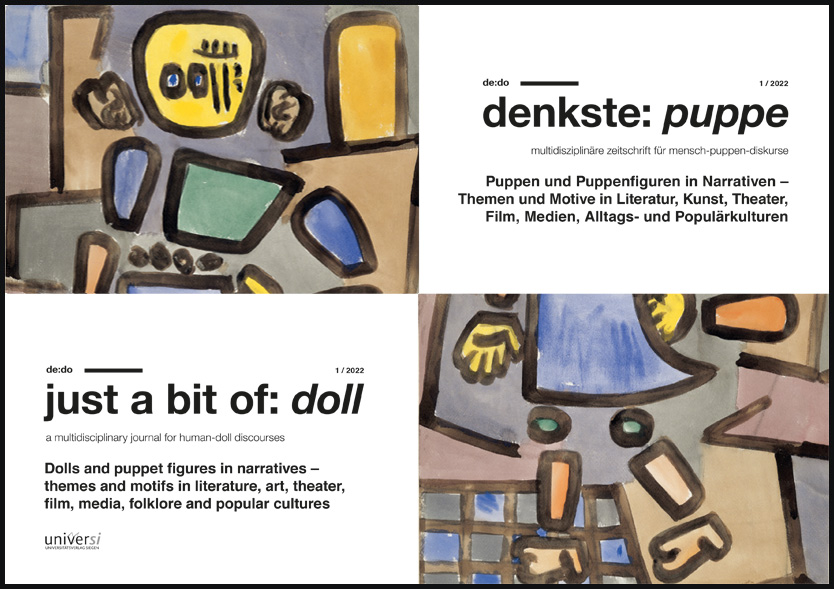
Dolls and puppet figures in narratives – themes and motifs in literature, art, theater, film, media, folklore and popular cultures
Vol. 5 No. 1 (2022)This thematic issue deals with the diversity and potential of doll/puppet narratives in the broadest sense and with their universal and/or culture-specific forms, traces, traditions and folklore as well as with the interplay of the respective reception references. These narratives are traced in a variety of different literary, artistic, cinematic, (pop-)cultural and folkloristic genres as well as in pedagogically relevant fields. In addition, s specially designed short graphic novel questions the linking of classic puppet theater narratives with seminal AI-based automation fantasies.
DOI:
doi.org/10.25819/ubsi/10165(Forwarding to the publication and document server OPUS Siegen) -
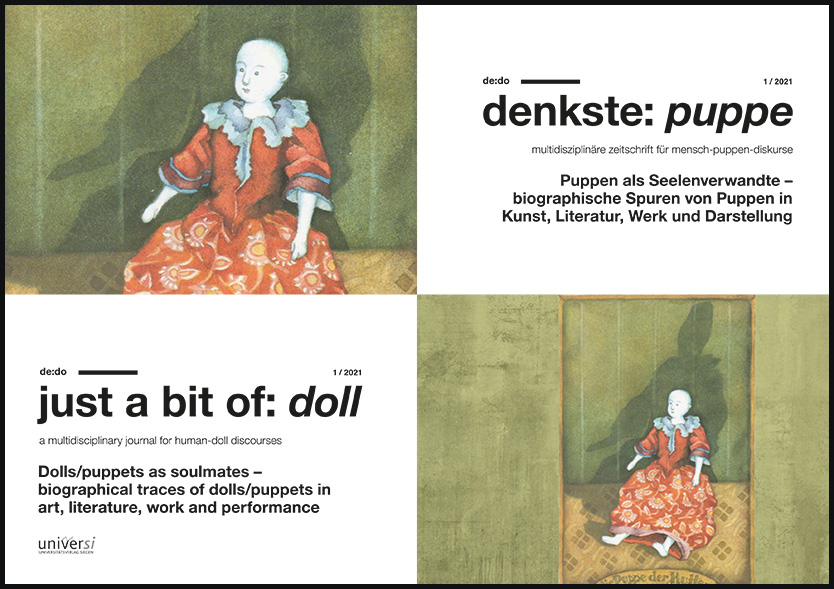
Dolls/puppets as soulmates – biographical traces of dolls/puppets in art, literature, work and performance
Vol. 4 No. 1 (2021)This fourth issue of de:do takes up the thematic focus on dolls/puppets as soulmates – biographical traces of dolls/puppets in art, literature, work and performance. It is about the impact of early doll experiences in later artistic work and thus about the possible (biographical) roots and connections of doll motifs and doll narratives in artistic-literary work. Doll/puppet references in work and creative processes can transform early experiences of biographical breaks and harm or integrate them in an artistically productive way, but they can also be an expression of continuity and intensification of early experience and preferences. The present contributions deal with doll/puppet-related artistic forms of expression, which are formally presented in different ways: as science-based text, self-report, miscellaneous, review, interview and: work of art. Doll/puppet collections, the making of particular puppets, literary puppet texts, performances and images are examined and addressed. In addition, further contributions were included, which deal with dolls as variants of "artificial humans" in the most diverse thematic contexts. Most of the contributions indicate that the affinity to the “phenomenon of the doll” in its various artistic forms of realization refers to biographically shaped traces: as a means of expression and representation the doll thus also stands for something special about the human beings who refer to it artistically and interact and "play" with it.
DOI:
doi.org/10.25819/ubsi/9992(Forwarding to the publication and document server OPUS Siegen) -
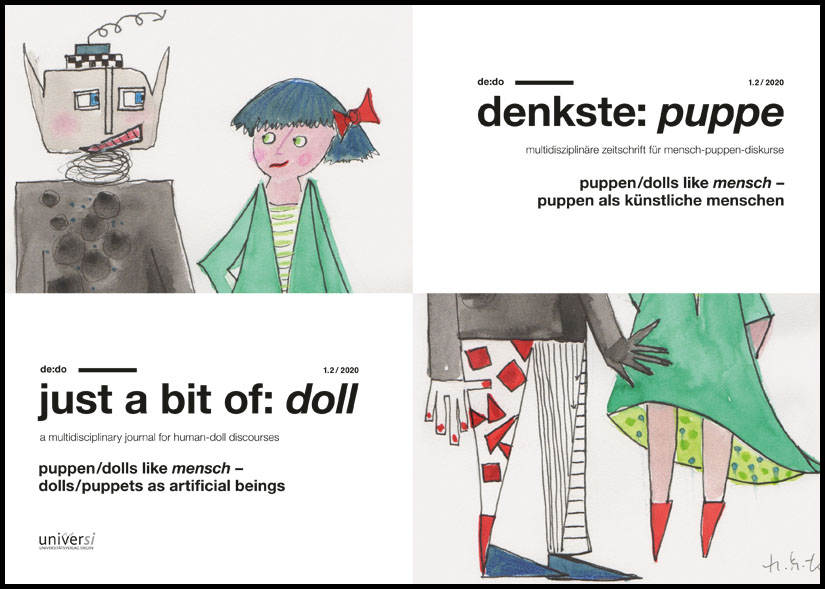
dolls/puppets like mensch – dolls/puppets as artificial beings. Part 1.2
Vol. 3 No. 1.2 (2020)The third edition de:do, a multidisciplinary online journal for human-doll discourses, is a double issue whose shared thematic focus is: puppen/dolls like mensch – dolls/puppets as artificial beings. With this focus, we take up a topic that has concerned mankind since ancient times and has always upset their 'minds' and 'hearts’, their needs and feelings. In mythologies, literary fictions and narratives for adults as well as for children, in works of the visual arts, in film, in mechanical-technical applications and utopias, in the performative arts, in (play-)pedagogy and in the various fields of pop culture, the motif of the doll with its various forms of expression always raises existential questions: Who is man, what is human? The doll as an artificial human being is in a certain way like mensch without being human. As man-made images, as models, imitations and designs of humans, dolls/puppets reflect and confirm existing worlds and at the same time sound out the potentials and abysses of being human between utopia and dystopia, between curiosity and devotion, between horror and bliss, between power and powerlessness. Dolls/puppets like mensch – the double meaning of these words emphasizes the given ambiguity of the dolls/puppets and the intriguing ambivalences inherent in them. In the first part of volume (1.1) the traces and manifestations of the doll motif and of doll(s) – as literary narrative, as artistic motif, as materialized object – will be explored primarily in the context of the fine arts, of literature, photography, theater and android technologies. In the second part of the volume (1.2), on the one hand, children's literature and (play)didactic texts are accentuated; on the other hand, various media and pop-cultural formats from the fields of computer games, comic-film adaptations, films (of different genres) and puppet theater performances are gathered here, as well as issues that link material artifacts and literary narratives. Reviews in the form of essays on literary doll narratives, a photo exhibition and a ballet round off both editions. The time span extends from the Middle Ages to the present and future and shows once again how age-old questions regarding mankind and humanity are integrated into traditional lines and are carried on continuously in fascinating ways.
DOI:
doi.org/10.25819/ubsi/5623(Forwarding to the publication and document server OPUS Siegen) -
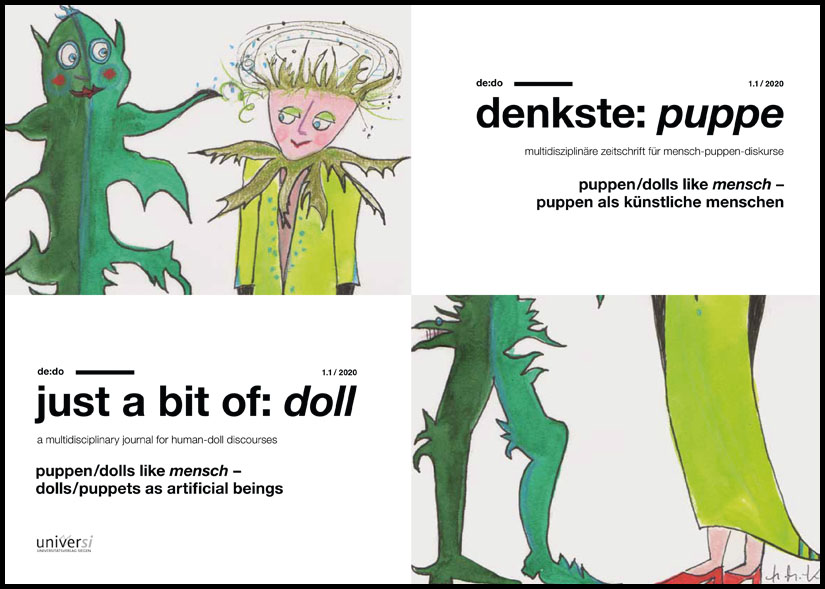
dolls/puppets as artificial beings. Part 1.1
Vol. 3 No. 1.1 (2020)The third edition of de:do, a multidisciplinary online journal for human-doll discourses, is a double issue whose shared thematic focus is: puppen/dolls like mensch – dolls/puppets as artificial beings. With this focus, we take up a topic that has concerned mankind since ancient times and has always upset their 'minds' and 'hearts’, their needs and feelings. In mythologies, literary fictions and narratives for adults as well as for children, in works of the visual arts, in film, in mechanical-technical applications and utopias, in the performative arts, in (play-)pedagogy and in the various fields of pop culture, the motif of the doll with its various forms of expression always raises existential questions: Who is man, what is human? The doll as an artificial human being is in a certain way like mensch without being human. As man-made images, as models, imitations and designs of humans, dolls/puppets reflect and confirm existing worlds and at the same time sound out the potentials and abysses of being human between utopia and dystopia, between curiosity and devotion, between horror and bliss, between power and powerlessness. Dolls/puppets like mensch – the double meaning of these words emphasizes the given ambiguity of the dolls/puppets and the intriguing ambivalences inherent in them. In the first part of volume (1.1) the traces and manifestations of the doll motif and of doll(s) – as literary narrative, as artistic motif, as materialized object – will be explored primarily in the context of the fine arts, of literature, photography, theater and android technologies. In the second part of the volume (1.2), on the one hand, children's literature and (play)didactic texts are accentuated; on the other hand, various media and pop-cultural formats from the fields of computer games, comic-film adaptations, films (of different genres) and puppet theater performances are gathered here, as well as issues that link material artifacts and literary narratives. Reviews in the form of essays on literary doll narratives, a photo exhibition and a ballet round off both editions. The time span extends from the Middle Ages to the present and future and shows once again how age-old questions regarding mankind and humanity are integrated into traditional lines and are carried on continuously in fascinating ways.
DOI:
doi.org/10.25819/ubsi/5594(Forwarding to the publication and document server OPUS Siegen) -
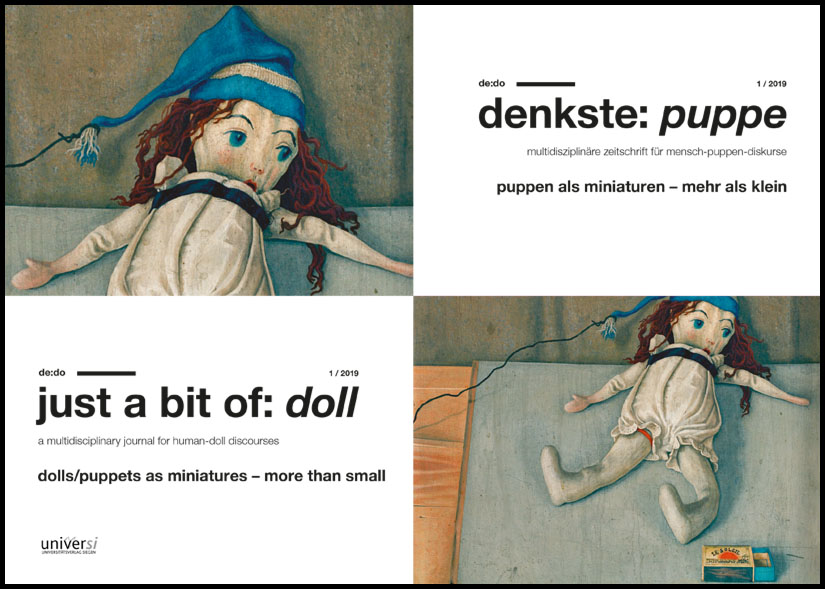
dolls/puppets as miniatures – more than small
Vol. 2 No. 1 (2019)The focus topic of the second edition of the journal de:do, a multidisciplinary, peer reviewed online journal for human-doll discourses is: dolls/puppets as miniatures - more than small. Dolls/puppets and their contexts claim to be ’more’ than just miniaturized variants or replicas of human worlds. Thus, it is not by chance that they are regarded as a ’place to find greatness’ (Bachelard). As ’small formats’, they generate images and narratives of their own kind which are open in function and effect: they oscillate between representation, condensation and transformation of reality, expressing longings and/or control needs of their creators and triggering enchantment, amazement or alienation while enabling a holistic access to the world and insight into inner contexts. Arguing in this line, dolls/puppets prove to be miniatures and – in the context of miniaturized worlds – hybrid objects, charged with all sorts of symbolism and excess of meaning. The synopsis of the highly diverse contributions in this issue gives us an idea of possible tensions – between ’small’ and ’large’, ’visible’ and ’hidden’, ’reality’ and ’fiction’, ’mimesis’ and ’poetics’. The heterogeneous range of topics underlines the subtle significance of the doll/puppet as a special trademark of the ’small form’ in many disciplines. The contributions come from subjects as archeology, anthropology, folklore, children’s and youth literature, art history, toy studies, animated film, fine arts, fashion design, forensics. An interview with a young artist, miscellaneous aspects as well as reviews complete the variety of topics.
URN:
nbn-resolving.org/urn:nbn:de:hbz:467-14632(Forwarding to the publication and document server OPUS Siegen) -
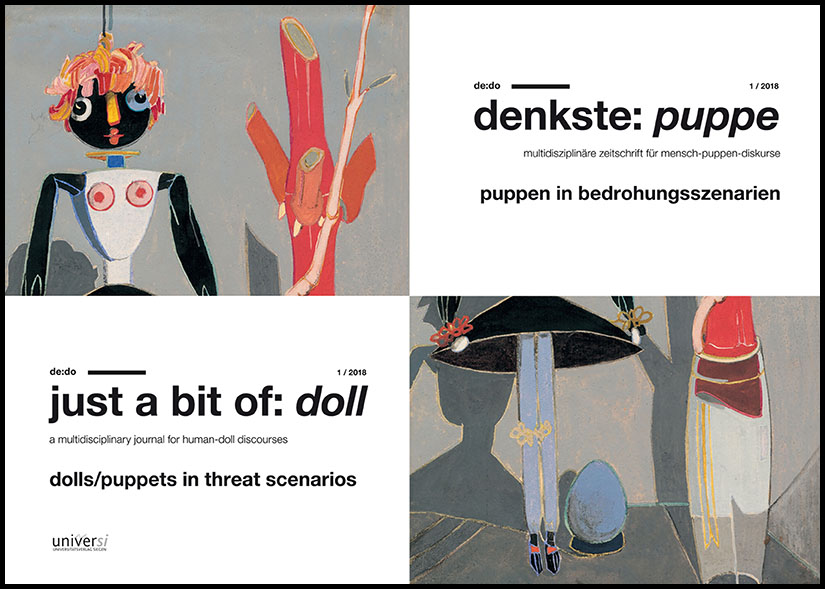
dolls/puppets in threat scenarios
Vol. 1 No. 1 (2018)Dolls / Puppets in Threat Scenarios – this is the topic focus of the first issue of the interdisciplinary online magazine denkste: puppe / just a bit of: doll on human-doll discourses (acronym: de:do). The term ’doll’ stands for anthropomorphic ’beings’ and artifacts of all kinds and the concept of threat is broadly defined. This focus was stimulated by the assumption that dolls and doll-related artifacts are of particular importance in times of existential threat as well as in phases of inner psychic anxiety and irritation. Yet, the basically ambiguous character of the doll does not necessarily determine a clear effect, so that its usability always involves a certain blurriness and ambivalence. In threatening and adverse situations dolls can act as companions and significant (transitional) objects, thus allowing psychic stabilization, security, and attachment as well as enabling (inner) autonomy, agency, and developmental processes. But dolls can also be a crucial component of threat scenarios themselves and act frightening in this function. All this applies not only to material and real existing dolls and puppets, but also to dolls as literary and / or media figures as well as to doll narratives of any kind. The articles included here come from different disciplines and open up an appealing and deliberately non-disciplinary oriented human-doll discourse from multiple perspectives. Accordingly, the relevant themes as well as the respective methodological approaches are highly heterogeneous. Thus, some contributions follow the long tradition of doll narratives in literature while others discuss currrent topics and discourses on future scenarios and new technologies by means of various doll-related media formats and / or art performances. A first thematic focus is on the significance of dolls in experiencing threats and losses in the context of war, flight and persecution in times of political uncertainty. Here, different facets of threat scenarios are addressed from different disciplinary perspectives. From the field of object and material theater two productions are introduced in which menacing war scenes are processed by means of plastic dolls or amorphous material. From a psychological perspective, dolls are discussed in their roles and functions as transitional objects within the context of upheaval, war and violence. Furthermore, two literary contributions analyze novels from children’s and youth literature. One story deals with a doll which contributes to the psychological stabilization of the literary protagonist. The other story tells of a girl and her doll which symbolizes the final farewell and eventual annihilation of the (Jewish) girl. Finally, the role of dolls and teddy bears in various children’s magazines is exemplified, which serve as identification figures and interaction partners for children in the politically unstable times between and after the two World Wars. A second focus deals with dolls and their narratives in the context of various aversive experiences as well as in times of psychological irritation. Two contributions analyze the meaning and effect of dolls in two ’classical’ doll narratives from a literary perspective: "Nussknacker und Mausekönig" by E.T.A. Hoffmann and "Romeo und Julia auf dem Dorfe" by Gottfried Keller. Further contributions address questions of ego dissolution, transformation and identity processes in human-doll relations from various perspectives such as media, art and children’s literature. Here, dolls appear as androids, artistic or anthropomorphic figures which cause irritation themselves or attempt to find answers to disturbing human-doll questions. In addition to the main topic, there are also a number of other sections and types of contributions on various doll-related topics and practices which once again document the wide range of doll narratives and possible forms of access: For example, a free contribution deals with doll play as a structured therapy for children, the miscellaneous section includes a portrait of Marlene Dietrich and her dolls as well as a short essay on a biographical reminiscence, an interview with the founder of the Berlin Puppet Theater bubales illustrates the possibilities of dramatic and poetic realization of puppet and doll narratives, a critical view on "Barbie as a discourse machine" is presented in the discussion forum and a review of the exhibition catalog "From Her Wooden Sleep by Ydessa Hendels" explores opportunities and limits of artistic work with doll artifacts.
URN: nbn-resolving.org/urn:nbn:de:hbz:467-1321 (Forwarding to the publication and document server OPUS Siegen)


